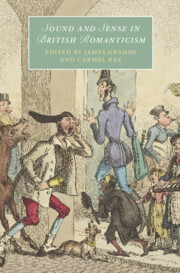Book contents
- Sound and Sense in British Romanticism
- Cambridge Studies in Romanticism
- Sound and Sense in British Romanticism
- Copyright page
- Contents
- Illustrations
- Music Examples
- Contributors
- Acknowledgements
- Introduction
- Chapter 1 William Hogarth
- Chapter 2 Collecting Ballads, Historicizing Sounds
- Chapter 3 Realising The Enraged Musician
- Chapter 4 ‘A Strange Jingle of Sounds’
- Chapter 5 The Sound of News
- Chapter 6 The Resounding Fame of Fingal’s Cave
- Chapter 7 Echoing Sounds
- Chapter 8 Mary Somerville’s Sound Accomplishments
- Chapter 9 Organizing Modernity
- Chapter 10 Stethoscopic Fantasies
- Bibliography
- Index
- Cambridge Studies in Romanticism
- References
Bibliography
Published online by Cambridge University Press: 24 August 2023
- Sound and Sense in British Romanticism
- Cambridge Studies in Romanticism
- Sound and Sense in British Romanticism
- Copyright page
- Contents
- Illustrations
- Music Examples
- Contributors
- Acknowledgements
- Introduction
- Chapter 1 William Hogarth
- Chapter 2 Collecting Ballads, Historicizing Sounds
- Chapter 3 Realising The Enraged Musician
- Chapter 4 ‘A Strange Jingle of Sounds’
- Chapter 5 The Sound of News
- Chapter 6 The Resounding Fame of Fingal’s Cave
- Chapter 7 Echoing Sounds
- Chapter 8 Mary Somerville’s Sound Accomplishments
- Chapter 9 Organizing Modernity
- Chapter 10 Stethoscopic Fantasies
- Bibliography
- Index
- Cambridge Studies in Romanticism
- References
Summary
- Type
- Chapter
- Information
- Sound and Sense in British Romanticism , pp. 245 - 271Publisher: Cambridge University PressPrint publication year: 2023
- Creative Commons
- This content is Open Access and distributed under the terms of the Creative Commons Attribution licence CC-BY-NC 4.0 https://creativecommons.org/cclicenses/



